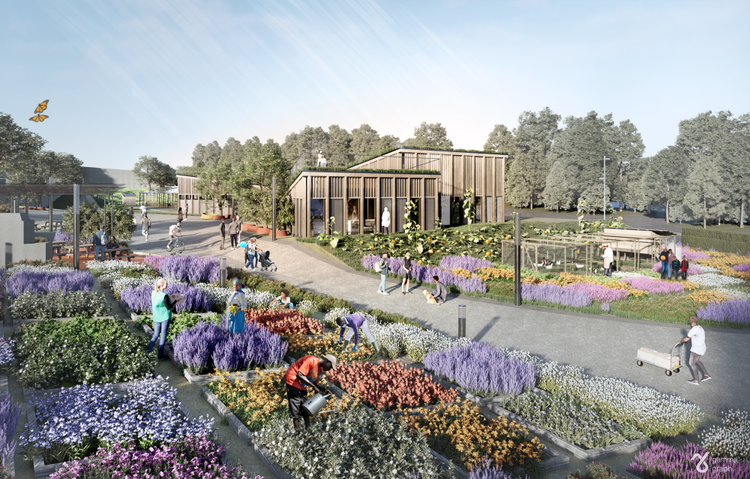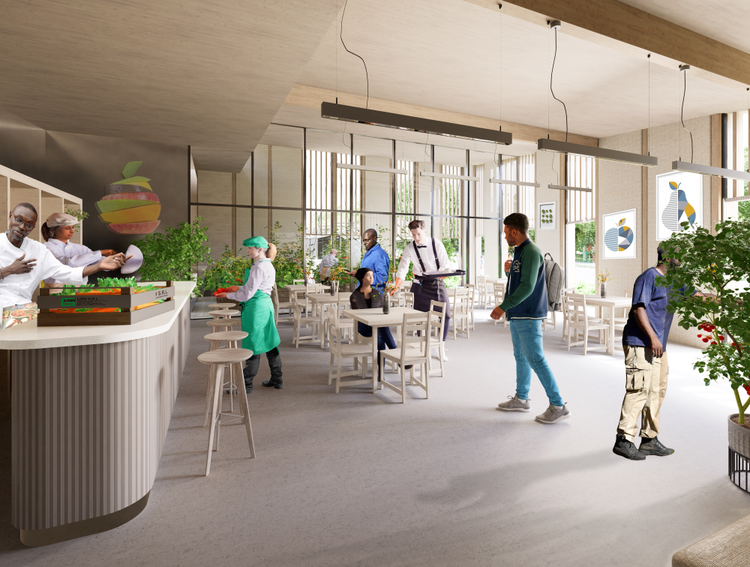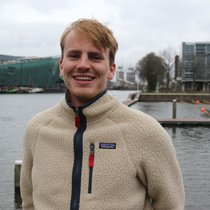The explosion in urban growth presents opportunities as well as challenges to, among others, our food systems. As a result, many cities are exploring how to create liveable and healthy environments for their citizens that also integrate sustainable ways to produce food.
To support these developments and explore the potential of urban farming, Wageningen University & Research (WUR) organizes an Urban Greenhouse Challenge every other year. For this challenge, students world-wide are invited to develop an urban farming business plan to be implemented in one of the world’s major metropoles.
The winning design of AMS Caterpillars
The team 'AMS Caterpillars', a group of students from our master’s degree Metropolitan Analysis Design and Engineering (MADE), took on WURs challenge and made it trough to the finals.
After multiple challenging rounds, we are proud to announce that this multidisciplinary team has won third prize, and was also awarded the Local Resident's Prize!
The challenge: Designing a urban farm with social impact for Washington, D.C
This year, WUR challenged student teams from all over the world to develop an urban farm that not only ensures food production but also generates income for local residents. More specified, a comprehensive plan to develop East Capitol Urban Farm (Washington, D.C.) into a site that:
- enables robust and resilient year-round sustainable food production
- while potentially creating social impact in this neighborhood which struggles with persistent and complex problems: poverty, unemployment and the lack of access to affordable and nutritious food, health services and good education.
Therefore, it is needed to think beyond financial sustainability. The site should foster social equity through a new type of food economy that eliminates food apartheid, contributes to creating jobs and incomes and promotes education. Furthermore, the site should become an attractive and significant landmark that celebrates local aesthetics and history.

Impression of AMS Caterpillar's design
The essence of 'AMS Caterpillars'
AMS Caterpillars aims with their concept to foster community spirit through an adaptive, self-sustaining urban farm that ensures local food security and economic viability, infrastructure longevity and meaningful public space.
Guided by their vision, they propose a holistic concept design. It incorporates the social, organizational, agricultural, economic, and spatial elements needed to establish an innovative, self-sustaining urban farm that improves food access and social cohesion of Ward 7, DC. The AMS Caterpillars aim to trigger a Butterfly Effect. Their proposal is the single flap of a wing of a butterfly, which sets in motion a chain of events. The concept implemented by the community establishes a flourishing urban farm and educational hub for Ward 7. The building outlines a butterfly, and want to let the community fill in its vibrant colors. The community-centered design draws from AMS Institute’s Living Lab approach that brings research into society-wide implementation through incorporating co-creation of different disciplines and stakeholders.

Impression of AMS Caterpillar's design
Five topics to be AMS Caterpillars unique differentiators
Living-Lab approach
Connecting education, research, food production and economics through continuous learning
Year-round food production, soil enhancement and education
Polyculture crops, outdoor and indoor growing for culturally appropriate & climate sensitive crops, and greenhouse dedicated to research & education.
Circularity and sustainable design
Circular food waste to energy cycle for powering the greenhouse and building. Other innovations are timber construction, efficient HVAC like geothermal heat pumps, passive design, anaerobic digestion, and on-site renewables.
Non-profit structure
Organizational structure & economic plan 501(c)(3) non-profit, unique partnerships for revenue generation, funding start-ups. Internal Integrated Design Framework (IDF).
A design process that bridges socio-technical disciplines
Our social-impact design is based upon integrating community needs & challenge outcomes with the UN Sustainable Development Goals.
Finally, they draw on inspiration from urban farms in the US and state-of-the-art innovations developed in Amsterdam. Their proposed combination of SDG alignment, interdisciplinary high-tech proposals, and global inspirations increases access to fresh produce, meaningful public space, and economic opportunity, contributing to improving the quality of life.
“Our concept embodies the metamorphosis of a caterpillar to butterfly, and the core of our mission is to preserve and support community spirit. We hope to provide the cocoon from which Ward 7’s butterflies can blossom.”
Mees Deknatel

AMS Institute is strongly committed to helping the next generation of ambitious urban and sustainable startups to turn their ideas into reality. Curious what we do to boost entrepreneurship and innovation within and for the city? These pages might spark your entrepreneurial spirits: